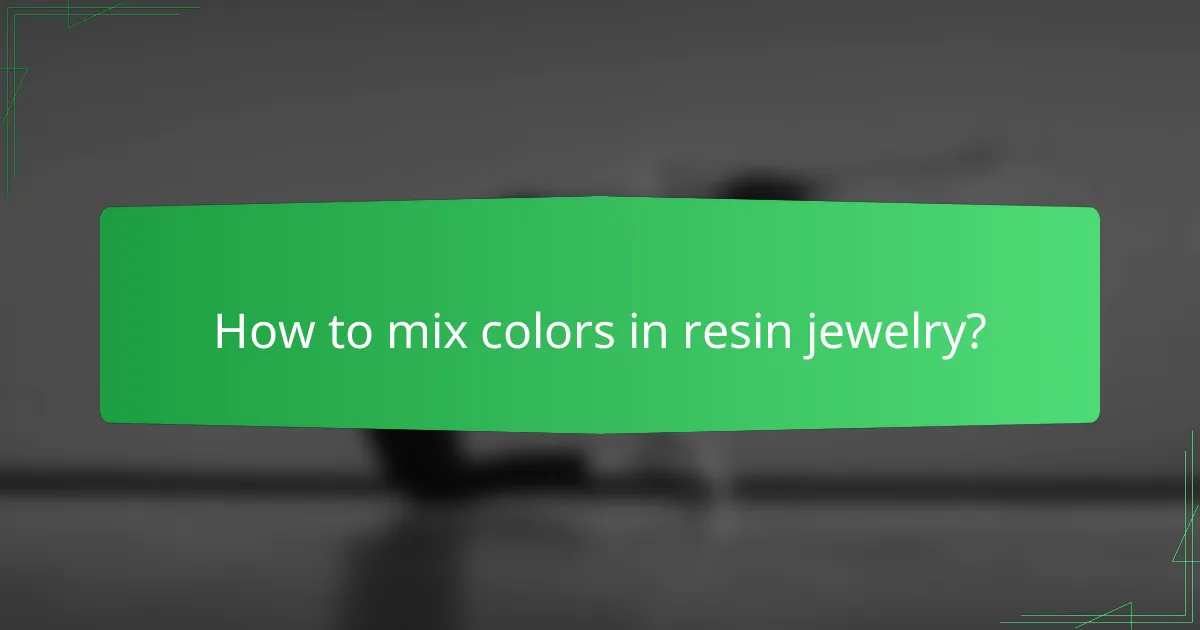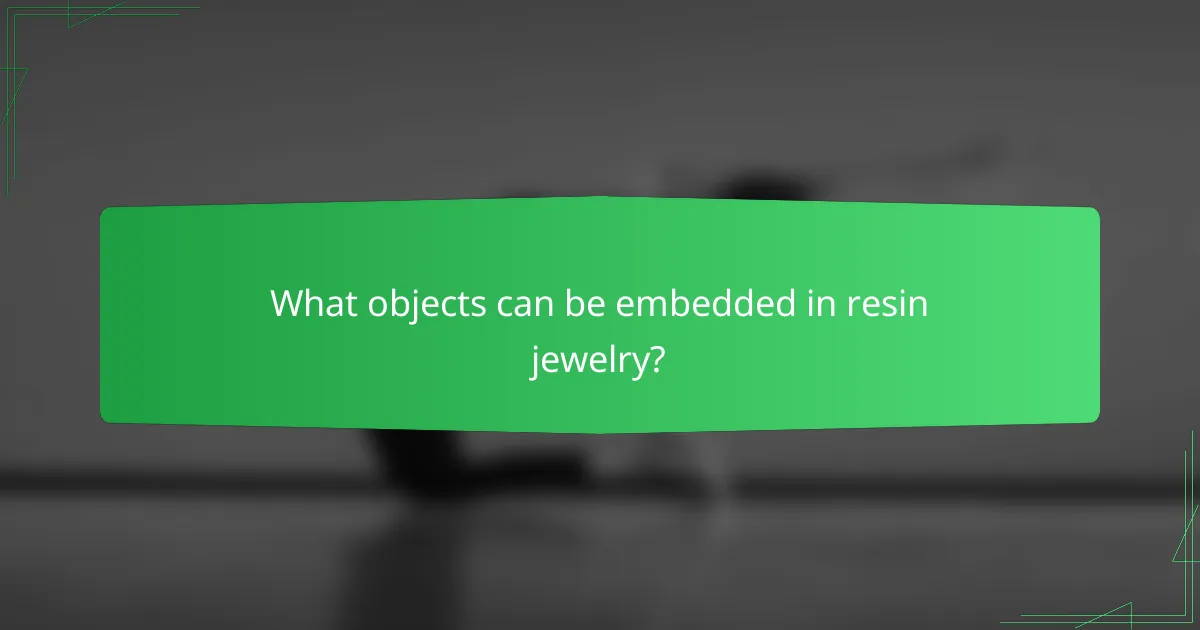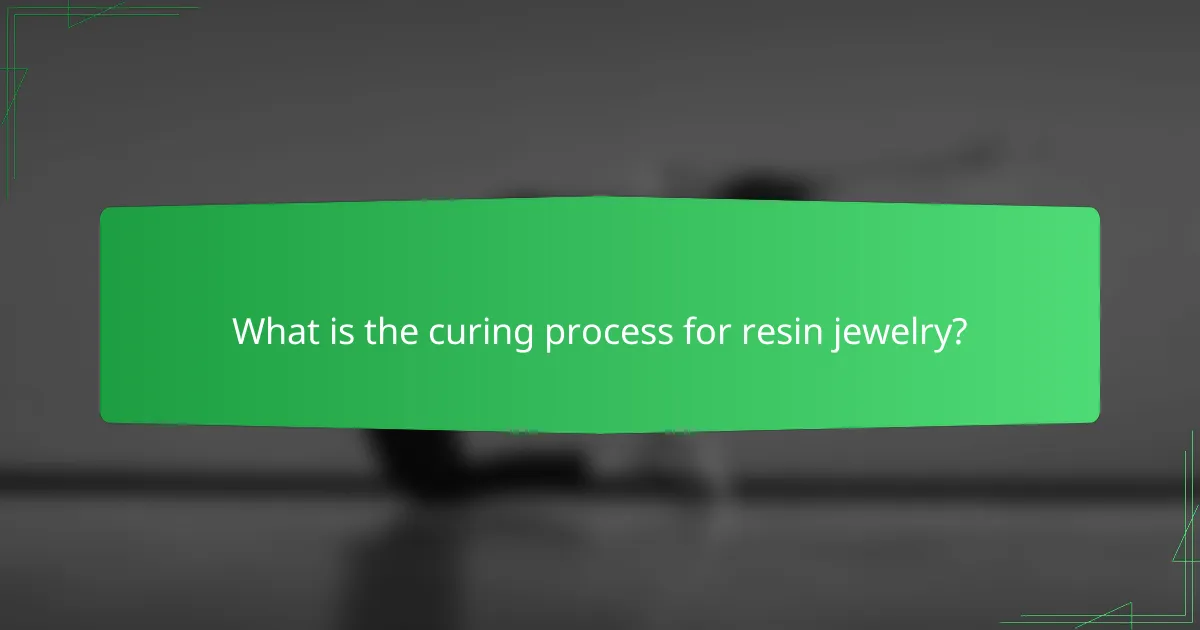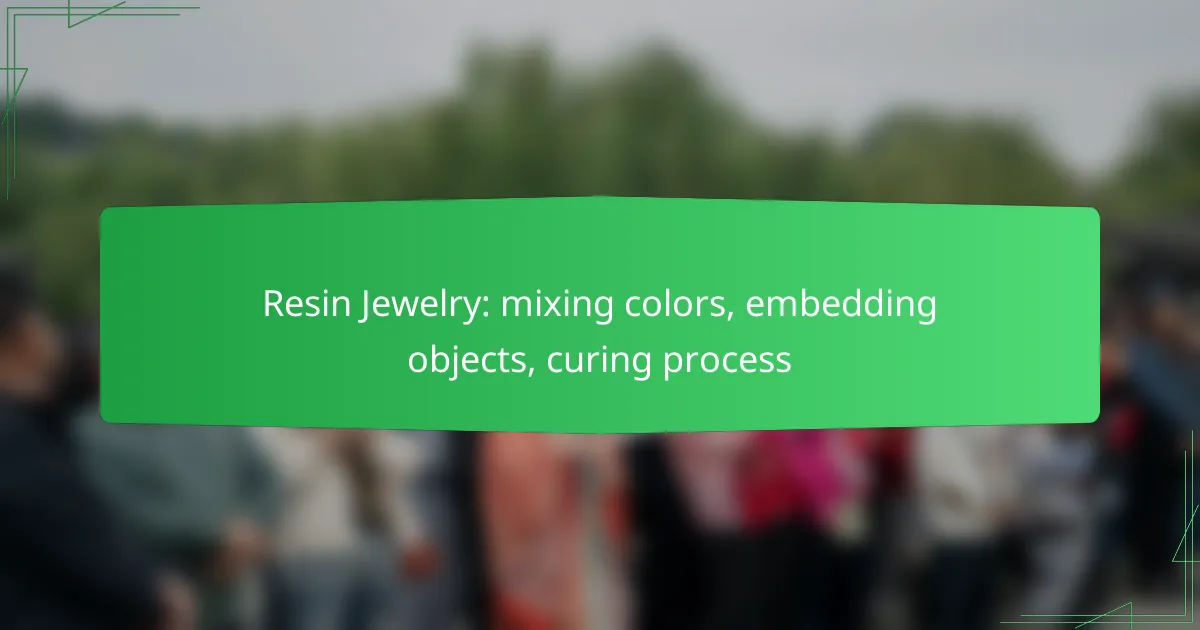Resin jewelry offers a unique opportunity for creativity through the mixing of colors and embedding of various objects. By combining pigments and additives, artisans can achieve stunning hues, while embedding items like natural materials or personal mementos adds depth and significance to each piece. The curing process transforms the liquid resin into a solid, durable material, making it ideal for crafting beautiful and lasting jewelry.

How to mix colors in resin jewelry?
Mixing colors in resin jewelry involves combining various pigments and additives to achieve the desired hue and effect. Understanding the different materials and techniques can enhance your creative process and the final appearance of your pieces.
Using color pigments
Color pigments are concentrated powders or liquids that provide vibrant hues to resin. When using pigments, start with a small amount and gradually increase until you reach your desired shade. It’s essential to mix thoroughly to avoid streaks and ensure even color distribution.
Common types of color pigments include liquid dyes, which are easy to blend, and solid pigments, which may require more effort to dissolve. Always check the manufacturer’s recommendations for the appropriate mixing ratios.
Incorporating mica powders
Mica powders add a shimmering effect to resin jewelry, creating depth and visual interest. These powders come in various colors and can be mixed with pigments for a unique finish. To use mica powders, simply add them to the resin mixture and stir until fully integrated.
Keep in mind that mica can settle over time, so it’s best to pour the resin soon after mixing. Experiment with different amounts to achieve the desired sparkle without overpowering the base color.
Creating color gradients
Color gradients can add a beautiful transition effect to your resin pieces. To create a gradient, start with a base color and gradually mix in a second color, ensuring to blend well at the junction. Pour the colors in layers, allowing each layer to partially cure before adding the next.
Using a heat gun or torch can help blend colors further, but be cautious to avoid overheating the resin. Practice on small samples to perfect your technique before applying it to larger projects.
Combining transparent and opaque colors
Combining transparent and opaque colors can create striking contrasts in your resin jewelry. Transparent colors allow light to pass through, while opaque colors block it, resulting in a dynamic visual effect. When mixing, consider the order of application; layering transparent colors over opaque can enhance depth.
To achieve a balanced look, use transparent colors sparingly, as they can easily dominate the design. Test different combinations on small pieces to see how they interact before committing to larger designs.

What objects can be embedded in resin jewelry?
Resin jewelry allows for the embedding of a variety of objects, enhancing its aesthetic appeal and personal significance. Common items include natural materials, craft supplies, small figurines, and personal mementos, each offering unique textures and colors.
Natural materials like flowers
Embedding natural materials such as dried flowers is a popular choice for resin jewelry. These materials can add vibrant colors and organic shapes, making each piece unique. When using flowers, ensure they are thoroughly dried to prevent moisture from causing issues during the curing process.
Consider using flowers that maintain their color well, such as lavender or roses. It’s best to use a thin layer of resin to encapsulate them, allowing for better visibility and a more delicate appearance.
Craft items such as glitter
Craft items like glitter can add sparkle and visual interest to resin jewelry. When choosing glitter, opt for high-quality, non-toxic varieties that are safe for skin contact. Mixing different colors and sizes of glitter can create stunning effects.
Be cautious not to overdo it; a little glitter goes a long way. Aim for a balanced look by combining glitter with other materials or colors to avoid overwhelming the design.
Small figurines and charms
Small figurines and charms can be embedded in resin to create personalized jewelry pieces. These items can range from tiny animals to meaningful symbols, allowing for a customized touch. Ensure that the figurines are clean and dry before embedding them.
Consider the size and weight of the figurines, as larger items may require more resin to secure properly. It’s advisable to position them in the center of the mold for an even look.
Personal mementos like photographs
Embedding personal mementos, such as photographs, adds sentimental value to resin jewelry. To do this effectively, use a photocopy or a printed image on suitable paper, as regular paper can warp when exposed to resin. Seal the image with a thin layer of resin before fully embedding it to prevent smudging.
Keep in mind that colors may shift slightly when encased in resin, so choose images with vibrant colors and clear details. This technique allows for a beautiful display of cherished memories in a wearable form.

What is the curing process for resin jewelry?
The curing process for resin jewelry involves the chemical hardening of resin after it has been mixed with a hardener. This transformation turns the liquid mixture into a solid, durable material suitable for crafting jewelry pieces.
Understanding epoxy resin curing
Epoxy resin curing is a chemical reaction that occurs when resin and hardener are combined. This process typically involves exothermic reactions, where heat is generated, leading to the hardening of the resin. The curing time and final properties depend on the specific resin formulation and the conditions under which it cures.
During curing, the resin transitions from a liquid state to a solid state, forming a strong bond. Proper mixing ratios and thorough blending are crucial for achieving optimal results, as uneven mixtures can lead to incomplete curing and compromised durability.
Temperature and humidity effects
Temperature and humidity significantly influence the curing process of resin. Ideally, resin should cure in a warm environment, typically between 20°C to 25°C (68°F to 77°F). Lower temperatures can slow down the curing time, while excessively high temperatures may cause the resin to cure too quickly, leading to defects.
Humidity levels can also affect the outcome. High humidity can introduce moisture into the resin, resulting in cloudiness or improper curing. It is best to work in a controlled environment with stable temperature and humidity for optimal results.
Timeframes for different resin types
The curing time for resin varies based on the type used. Generally, standard epoxy resins can take anywhere from 24 to 72 hours to fully cure, while fast-curing options may set in just a few hours. Some specialty resins, like UV resin, can cure within minutes under UV light.
Understanding the specific curing times for the resin you are using is essential for planning your projects. Always refer to the manufacturer’s guidelines for the best results, as they provide the most accurate information regarding curing times and conditions.

What tools are needed for resin jewelry making?
To create resin jewelry, you will need specific tools that facilitate the mixing, shaping, and safety of the process. Essential items include mixing cups, stir sticks, silicone molds, and protective gear to ensure a successful and safe crafting experience.
Mixing cups and stir sticks
Mixing cups are crucial for combining resin and hardener in the correct ratios. Look for clear, graduated cups that allow you to measure accurately, as precision is key to achieving the desired curing results. Stir sticks, preferably wooden or plastic, help ensure thorough mixing without introducing bubbles.
When selecting mixing cups, consider using disposable options for easy cleanup. Avoid using cups that have previously contained food or chemicals, as residues can interfere with the curing process.
Silicone molds for shaping
Silicone molds are essential for shaping your resin into various designs and forms. They come in numerous shapes and sizes, allowing for creativity in your jewelry pieces. Ensure the molds are flexible, which makes demolding easier once the resin has cured.
When choosing molds, consider the thickness and detail of the design. Thinner molds may require more careful handling, while thicker molds can provide sturdier shapes. Always check for compatibility with resin to avoid any chemical reactions.
Protective gear like gloves and masks
Protective gear is vital when working with resin to ensure your safety. Nitrile gloves protect your skin from potential irritation caused by resin, while a mask can prevent inhalation of fumes during the mixing and curing process. Always prioritize your safety by wearing these items.
When selecting gloves, ensure they fit well and are resistant to chemicals. For masks, look for those rated for organic vapors to effectively filter harmful substances. Regularly check your gear for any signs of wear or damage before starting your project.

How to choose the right resin for jewelry making?
Choosing the right resin for jewelry making involves considering factors like the type of resin, its properties, and how they align with your project goals. Common options include epoxy and polyurethane resins, each with unique characteristics that affect durability, clarity, and ease of use.
Comparing epoxy vs. polyurethane resin
Epoxy resin is known for its excellent clarity and strong adhesion, making it a popular choice for jewelry. It typically cures more slowly, allowing for better mixing of colors and embedding objects. Polyurethane resin, on the other hand, cures faster and is more flexible, which can be advantageous for certain designs but may sacrifice some clarity.
When selecting between the two, consider the specific requirements of your project. If you need a high-gloss finish and extended working time, epoxy is usually preferable. For quicker projects that require flexibility, polyurethane might be the better option.
Evaluating UV resistance
UV resistance is crucial for jewelry that will be exposed to sunlight, as some resins can yellow over time. Epoxy resins generally offer better UV resistance compared to polyurethane, making them suitable for outdoor wear. However, some polyurethane formulations are specifically designed to resist UV damage.
To ensure longevity, look for resins labeled as UV-resistant. This can help maintain the aesthetic appeal of your jewelry, especially for pieces that incorporate vibrant colors or delicate details.
Assessing clarity and finish
The clarity and finish of the resin significantly impact the final appearance of your jewelry. Epoxy resins typically provide a glass-like finish that enhances the colors and embedded objects. Polyurethane resins can vary in clarity, so it’s essential to choose a high-quality product for the best results.
When testing resins, consider pouring small samples to evaluate their clarity and finish before committing to a larger project. This practice can help you avoid common pitfalls and ensure your jewelry has the desired visual impact.

What are the safety precautions for working with resin?
When working with resin, it is crucial to prioritize safety by using appropriate protective gear and ensuring proper workspace conditions. This minimizes exposure to potentially harmful fumes and skin irritants associated with resin materials.
Using proper ventilation
Proper ventilation is essential when working with resin to avoid inhaling toxic fumes. Always work in a well-ventilated area, such as an open garage or outdoors, to allow for adequate air circulation.
If indoors, consider using exhaust fans or air purifiers with activated carbon filters to help remove harmful particles from the air. Aim for a space where fresh air can continuously flow, reducing the concentration of fumes.
As a general rule, if you can smell the resin, it indicates that you need better ventilation. Regular breaks in fresh air can also help mitigate exposure during longer projects.
